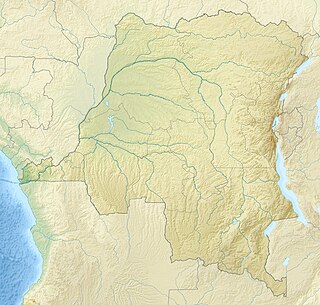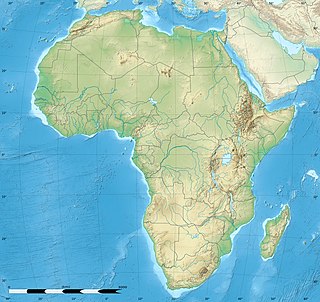Related Research Articles

The Black Forest is a large, forested mountain range in the state of Baden-Württemberg in southwest Germany. It is bounded by the Rhine valley to the west and south. Its highest peak is the Feldberg with an elevation of 1,493 metres (4,898 ft) above sea level. The region is roughly oblong in shape, with a length of 160 kilometres and breadth of up to 50 km (30 mi).
The History of Malawi covers the area of present-day Malawi. The region was once part of the Maravi Empire. In colonial times, the territory was ruled by the British, under whose control it was known first as British Central Africa and later Nyasaland. It became part of the Federation of Rhodesia and Nyasaland. The country achieved full independence, as Malawi, in 1964. After independence, Malawi was ruled as a one-party state under Hastings Banda until 1994.

Sir Henry Morton Stanley was a Welsh journalist and explorer who was famous for his exploration of central Africa, and his search for missionary and explorer David Livingstone, whom he later claimed to have greeted with the now-famous line: "Dr Livingstone, I presume?" He is mainly known for his search for the source of the Nile, work he undertook as an agent of King Leopold II of Belgium, which enabled the occupation of the Congo Basin region, and for his command of the Emin Pasha Relief Expedition. He was knighted in 1899.

David Livingstone was a Scottish physician, Congregationalist, and pioneer Christian missionary with the London Missionary Society, an explorer in Africa, and one of the most popular British heroes of the late 19th-century Victorian era. He had a mythic status that operated on a number of interconnected levels: Protestant missionary martyr, working-class "rags-to-riches" inspirational story, scientific investigator and explorer, imperial reformer, anti-slavery crusader, and advocate of British commercial and colonial expansion.

Freiburg im Breisgau is a city in Baden-Württemberg, Germany, with a population of about 220,000. In the south-west of the country, it straddles the Dreisam river, at the foot of the Schlossberg. Historically, the city has acted as the hub of the Breisgau region on the western edge of the Black Forest in the Upper Rhine Plain. A famous old German university town, and archiepiscopal seat, Freiburg was incorporated in the early twelfth century and developed into a major commercial, intellectual, and ecclesiastical center of the upper Rhine region. The city is known for its medieval minster and Renaissance university, as well as for its high standard of living and advanced environmental practices. The city is situated in the heart of the major Baden wine-growing region and serves as the primary tourist entry point to the scenic beauty of the Black Forest. According to meteorological statistics, the city is the sunniest and warmest in Germany, and held the all-time German temperature record of 40.2 °C (104.4 °F) from 2003 to 2015.

German East Africa (GEA) was a German colony in the African Great Lakes region, which included present-day Burundi, Rwanda, and the mainland part of Tanzania. GEA's area was 994,996 square kilometres (384,170 sq mi), which was nearly three times the area of present-day Germany, and double the area of metropolitan Germany then.

The British Central Africa Protectorate (BCA) was a British protectorate proclaimed in 1889 and ratified in 1891 that occupied the same area as present-day Malawi: it was renamed Nyasaland in 1907. British interest in the area arose from visits made by David Livingstone from 1858 onward during his exploration of the Zambezi area. This encouraged missionary activity that started in the 1860s, undertaken by the Universities' Mission to Central Africa, the Church of Scotland and the Free Church of Scotland, and which was followed by a small number of settlers. The Portuguese government attempted to claim much of the area in which the missionaries and settlers operated, but this was disputed by the British government. To forestall a Portuguese expedition claiming effective occupation, a protectorate was proclaimed, first over the south of this area, then over the whole of it in 1889. After negotiations with the Portuguese and German governments on its boundaries, the protectorate was formally ratified by the British government in May 1891.

Sir Henry Hamilton Johnston, frequently known as Harry Johnston, was a British explorer, botanist, artist, colonial administrator and linguist who traveled widely in Africa and spoke many African languages. He published 40 books on African subjects and was one of the key players in the Scramble for Africa that occurred at the end of the 19th century.

The Scramble for Africa, also called the Partition of Africa or the Conquest of Africa, was the invasion, occupation, division, and colonisation of African territory by European powers during a short period known to historians as the New Imperialism. In 1870, only 10 percent of Africa was under formal European control; by 1914 this had increased to almost 90 percent of the continent, with only Ethiopia (Abyssinia), the Dervish state and Liberia remaining independent. The European colonialists had several motives: a desire for valuable natural resources, the quest for national prestige, rivalry between European powers, and religious missionary zeal. Internal African native politics also played a role.

Joseph Thomson was a Scottish geologist and explorer who played an important part in the Scramble for Africa. Thomson's gazelle and Thomson's Falls, Nyahururu are named after him. Excelling as an explorer rather than an exact scientist, he avoided confrontations among his porters or with indigenous peoples, neither killing any native nor losing any of his men to violence. His motto is often quoted to be "He who goes gently, goes safely; he who goes safely, goes far."

The geography of North Africa has been reasonably well known among Europeans since classical antiquity in Greco-Roman geography. Northwest Africa was known as either Libya or Africa, while Egypt was considered part of Asia.
The Kipengere Range, also known as the Livingstone Mountains, lies in southwest Tanzania at the northern end of Lake Malawi. Near Lake Malawi they are known as the Kinga Mountains. It is a plateau-like ridge of mountains running southeastwards from the basin of the Great Ruaha River in the north to that of the Ruhuhu River in the south, and forms part of the eastern escarpment of the East African Rift. The range is mostly clad in montane grasslands, renowned for their botanical diversity and displays of flowers, with montane evergreen forests mostly in stream valleys.

Gustav Adolf Graf von Götzen was a German explorer and Governor of German East Africa. He came to Rwanda in 1894 at the head of a troop of 620 soldiers, becoming the second European to set foot in Rwanda, after Oscar Baumann, and later became the first European to cross the length of Rwanda. Götzen was the first governor of German East Africa.

Johannes Rebmann was a German missionary and explorer credited with feats including being the first European, along with his colleague Johann Ludwig Krapf, to enter Africa from the Indian Ocean coast. In addition, he was the first European to find Kilimanjaro. News of Rebmann's discovery was published in the Church Missionary Intelligencer in May 1849, but disregarded as mere fantasy for the next twelve years. The Geographical Society of London held that snow could not possibly occur let alone persist in such latitudes and considered the report to be the hallucination of a malaria-stricken missionary. It was only in 1861 that researchers began their efforts to measure Kilimanjaro. Expeditions to Tanzania between 1861 and 1865, led by the German Baron Karl Klaus von der Decken, confirmed Rebmann’s report. Together with his colleague Johann Ludwig Krapf they were also the first Europeans to visit and report Mt. Kenya. Their work there is also thought to have had effects on future African expeditions by Europeans, including the exploits of Sir Richard Burton, John Hanning Speke, and David Livingstone. After losing most of his eyesight and entering into a brief marriage, he died of pneumonia.
Friedrich Fülleborn was a physician who specialized in tropical medicine and parasitology. He was a native of Kulm, West Prussia, which today is known as Chełmno, Poland.

The Marungu highlands are in the Katanga Province of the Democratic Republic of the Congo, to the west of the southern half of Lake Tanganyika.
Paul Reichard was a German explorer who traveled extensively in Africa. His discoveries led to the establishment of the German East Africa Protectorate.
A. L. Bruce Estates was one of three largest owners of agricultural estates in colonial Nyasaland. Alexander Low Bruce, the son-in-law of David Livingstone, acquired a large estate at Magomero in the Shire Highlands of Nyasaland in 1893, together with two smaller ones. On his death, these estates were to operate as a trust to bring Christianity and Commerce to Central Africa. However his two sons later formed a commercial company which bought the estates from the trust. The company gained a reputation for the harsh exploitation and ill-treatment of its tenants under a labour system known by the African term "thangata", which operated in the plantation cultivation of cotton and tobacco. This exploitation was one of the causes of the 1915 uprising led by John Chilembwe, which resulted in the deaths of three of the company's European employees. After the failure of its own cotton and tobacco plantations, the company forced its tenants to grow tobacco rather than food on their own land and significantly underpaid them. Following almost three decades of losses, the Magomero estate was in poor condition, but the company was able to sell it at a profit between 1949 and 1952 because the government needed land for resettlement of African former tenants evicted from private estates. The company was liquidated in 1959.

Lake Uniamési or the Uniamesi Sea was the name given by missionaries in the 1840s and 1850s to a huge lake or inland sea they supposed to lie within a region of Central East Africa with the same name.
William Desborough Cooley (1795?–1883) was an Irish geographer. Discoveries by European explorers gradually showed that a number of his theories about Central Africa, though strongly held, were incorrect. In other controversies his position is now considered to have had some justification. His major contributions are now seen as relating to source criticism of historical records, the understanding of West Africa, and as a perceptive historian of globalisation.
References
- Adams, A. (1899). Im Dienste des Kreuzes, Errinerungen aus meinen Missionsleben in Deutsch-Ostafrika. Augsburg: St. Ottilien.
- Fülleborn, F. (1906). Das Deutsche Njassa- und Ruwuma-Gebeit, Land und Leute nebst Bemerkungen über du Schire-Länder. Berlin: Dietrich Reimer.
- Stirnimann, H. (1976). Existenzgrundlagen und Traditionelles Handwerk der Pangwa von SW.-Tansania. Freiburg: Universitätsverlag Freiburg Schweiz.
- Thomson, J. (1881). To the Central African Lakes and Back: The Narrative of the Royal Geographical Society’s East Central African Expedition 1878-80 (Vol. I). London: Sampson Low, Marston, Searle & Rivington.
| This article about a Tanzanian ethnicity is a stub. You can help Wikipedia by expanding it. |